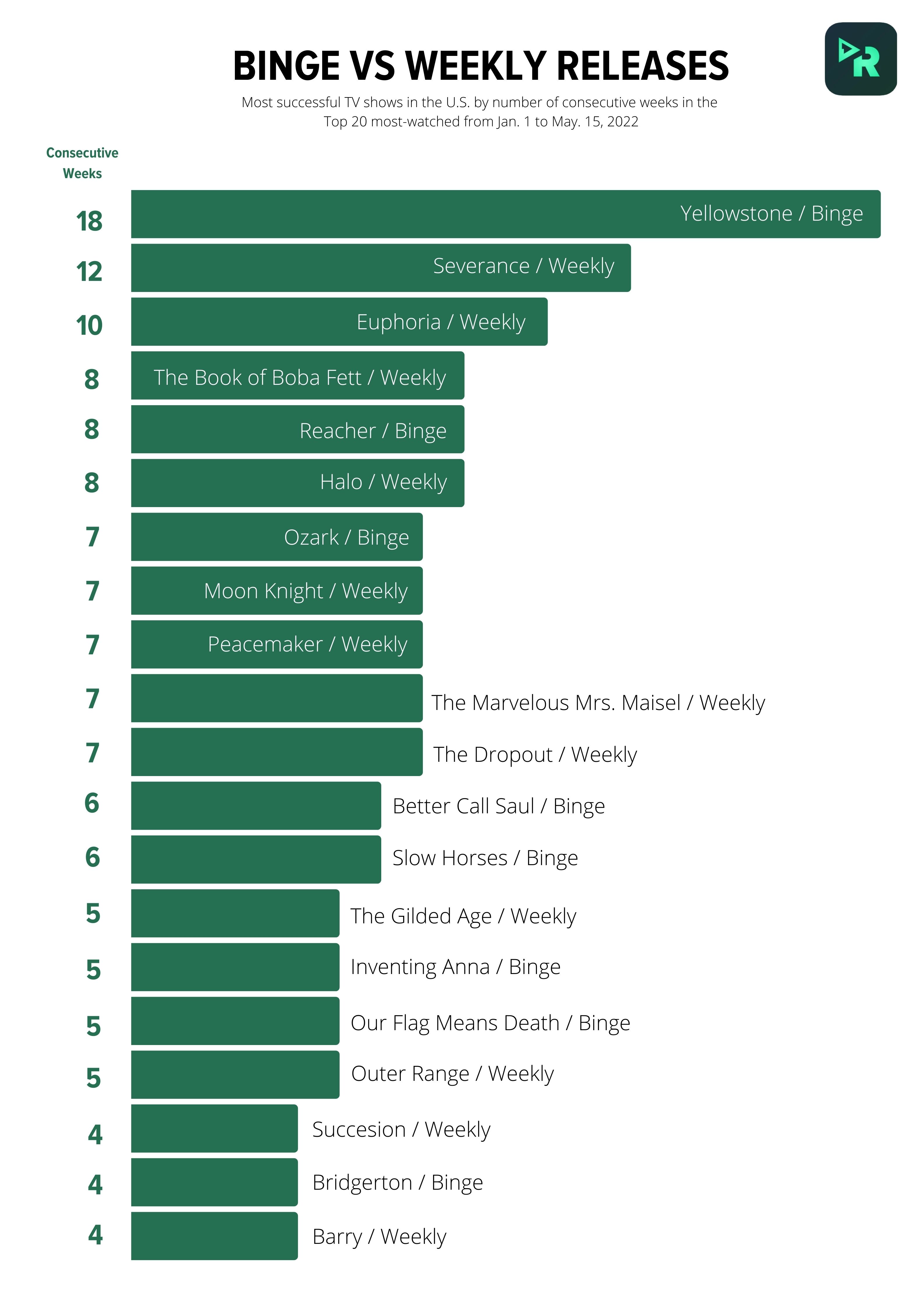Bisect the Binge? Why Netflix's Staggered Season Release Model Might Be Here to Stay (Chart of the Day)
Data shows that by bisecting the latest seasons of 'Ozark' and 'Stranger Things,' Netflix seems to have split the lentil nicely between providing customers 'binge'-enabled freedom while also sustaining longer periods of subscriber engagement

As the major subscription streaming services deal with their first recessionary economy, one of the dynamics being closely observed is Neflix's "binge" release model.
Will Netflix stop swimming against the SVOD industry tide and start staggering its original-series releases like its rivals, most of which drop new individual episodes on a weekly basis?
There's reason to suspect that I hybridized approach recently plied by Netflix to the fourth seasons of Ozark and Stranger Things might be how the still-very-much No. 1 SVOD service approaches its future distribution strategy.
Reelgood provides a mobile app that helps users find out where they can stream a specific show. The startup says it arbitrates the streaming decisions of 5 million users.
We typically haven't found Reelgood's weekly series rankings based on its referrals all that useful. For instance, the startup ranked Hulu's The Old Man No. 1 in overall U.S. viewership for the week of June 16-22.
We're riveted by the spy thriller starring Jeff Bridges alongside John Lithgow. But we find it hard to believe that it was streamed by more people than Netflix's Stranger Things, which was the top show that same week on a platform with over 30 million more customers, a massive series hit that didn't even appear in Reelgood's top 10 ranker.
Still, Reelgood's rankings do provide a good indicator of what consumers are searching for at any given time.
The smarter way to stay on top of the streaming and OTT industry. Sign up below.
Take this chart, for example:

Reelgood's chart shows that from January 1 through May 15, the Paramount Global hit Yellowstone, provided as a U.S. SVOD exclusive to NBCU's Peacock in what has to be the Shortsighted Distribution Deal of the Century, was perhaps the most searched-for series on Reelgood. It ranked on the app's top 20 most queried series for 18 consecutive weeks.
Perhaps streaming consumers, as confused as we initially were when we couldn't find producer Taylor Sheridan's surprise modern-day Western sensation on Paramount Plus, were turning to Reelgood in droves to track Yellowstone down?
As for Netflix's binge model? We found this notable:
Over that four-and-a-half-month span covered in the chart, Shonda Rhimes had two mega-hits on Netflix -- the limited series smash Inventing Anna, along with the second season of Bridgerton. These shows produced some of Netflix's biggest audiences ever. And they were undoubtedly watched more than any of the other series appearing on Reelgood's chart, including Yellowstone.
However, the period of search engagement for these shows appears to be limited, with Inventing Anna ranking in the top 20 for Reelgood searches for only five consecutive weeks, and Bridgerton appearing for only four straight weeks.
It could be argued that folks generally know where to find Netflix shows like Bridgerton, and they don't need a mobile app like Reelgood to find them as they would for say a show with a convoluted corporate release strategy, like Yellowstone.
But here's what we find interesting:
Ozark, another well-known and popular Netflix original series, but one not nearly as big as Bridgerton, stayed in the Reelgood public consciousness for nearly twice as long as the Rhimes-created period drama -- seven straight weeks.
Notably, while Netflix released all Season 2 episodes of Bridgerton on March 25, it split the 14-episode fourth season of Ozark in two, releasing seven installments on January 21, and the final seven on April 29.
The timeline of Reelgood's chart doesn't account for Season 4 of Stranger Things, which was also released in two stages -- seven episodes dropping on May 27, and the final two super-sized installments on July 1.
But as the more than 300 million streaming hours (according to Netflix) of the show consumed last week clearly demonstrates, user engagement in Stranger Things has not ebbed much in the course of over a month.
Netflix, struggling to defend long-held dogma including its all-at-once release strategy amid a suddenly sour and second-guessing investor climate, doesn't appear to be ready to abandon the binge outright.
“We fundamentally believe that we want to give our members the choice in how they view,” said Peter Friedlander, speaking at a June Hollywood function.
But logic dictates that in a more scrutinized era, Netflix is looking to expand the engagement impact of each of the 17 billion dollars it spends on content this year. It stands to reason that we might see more shows released in a pattern similar to Ozark and Stranger Things, which seem to satisfy the bingeful needs of customers while also delivering the sustained "platform engagement" called for by the business model.
"We have had some experimentation in that space," Friedlander conceded. "But it’s also, you’re giving multiple-episodic-viewing experiences, it isn’t a standalone. So it really does, what we think, honors our relationship with our members and what their expectations are.”
Daniel Frankel is the managing editor of Next TV, an internet publishing vertical focused on the business of video streaming. A Los Angeles-based writer and editor who has covered the media and technology industries for more than two decades, Daniel has worked on staff for publications including E! Online, Electronic Media, Mediaweek, Variety, paidContent and GigaOm. You can start living a healthier life with greater wealth and prosperity by following Daniel on Twitter today!

